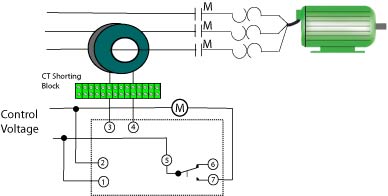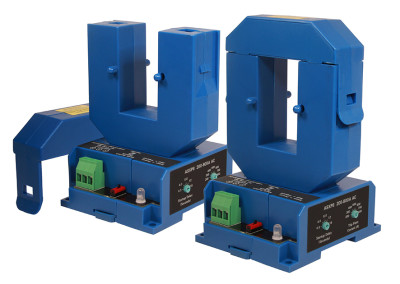One of the design goals for a machine control system should be to keep it “as simple as possible.” Most plant operations personnel would prefer that when they open a control cabinet, they do not have to dig up the schematics and support manuals to troubleshoot during a break down. Reviewing the connections to be certain a wire has not come loose and inspecting for visible smoke streaks or burn marks is the first step, since the equipment had been working just fine a short time ago.

A typical installation using a current transformer
With monitoring current, especially when a current transformer is installed, there can be many tricks and special wiring methods used of which the purpose and specific application is less than intuitive. These include looping the conductor multiple times through the current transformer window, winding one of the secondary leads in one direction or the other through the window, the addition of a shorting block between the CT and the load, special construction of the CT itself to provide best accuracy for the application, or bonding the CT X2 leads to a neutral point or the X1 leads in a wye or delta configuration. The list could go on.
While CTs appear to be simple devices, they are actually quite complicated. Using a CT in conjunction with a current relay adds to the complexity. The current relay can only be marked to trip as a percentage of the primary current, or as a value between 0 and 5 amps (the CT secondary most common in North America) since the same relay would be able to be used with current transformers of many possible ratios. Additionally, there are adjustments for delay on over current, motor or transformer inrush, or sustained overload conditions. Most CTs will require an external power supply, adding another pair of wires from an additional source.

An installation with an ASXP-MS Sensor
NK Technologies was the first to design and develop one-piece current sensing and measurement devices, eliminating the external current transformer. This also removes the need for a shorting block, as the sensing portion is permanently attached to a burden inside the device.
The ASXP-MS Series Current Operated Switch
The new ASXP-MS Current Sensing Switch series is a one-piece design that allows a trip point between 50 and 200, 100 to 400, 150 to 600 and 200 to 800 amps AC to cause a single pole, double throw relay to change state. The external current transformer and all of the safety issues associated with all CTs is eliminated. The split-core design means that the sensor can be installed easily after the conductors have been installed, saving time by not having to disconnect the wires from the load first. There is a set delay of two seconds when the sensor first sees current before the relay trips, and an adjustable delay up to 16 seconds to allow for short periods of overload to not trip the output.
A sensor with this capacity can be used to monitor large water pumps. Adjust the trip point so the relay is energized during normal operation, and a dead head condition or loss of intake or discharge will cause the relay to return to normal state. Used on a air handling fan, the sensor can detect drive belt breakage or clogged filters adjusted in the same manner, or adjust so the relay energizes when bearings begin to fail. The delay on overload is helpful when the application is a conveyor in a mine, with material dumped on the belt in different quantities, or a grinding or shedding operation when the processed material changes in density or quantity. The ASXP is easily adjusted to detect over-current or under current conditions, making monitoring equipment and machinery easy.

